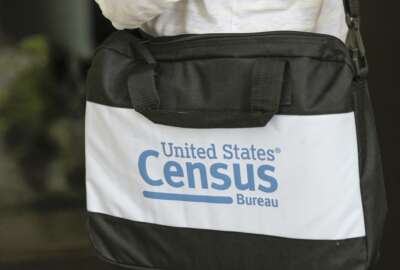
Evaluating EPA’s protocols on returning to the office
A recent inspector general report found that Environmental Protection Agency labs and offices were inconsistent in how they enforced pandemic protocols as employees...
Best listening experience is on Chrome, Firefox or Safari. Subscribe to Federal Drive’s daily audio interviews on Apple Podcasts or PodcastOne.
A recent inspector general report found that Environmental Protection Agency labs and offices were inconsistent in how they enforced pandemic protocols as employees returned to the office. For details, Federal Drive with Tom Temin producer Eric White spoke to the Auditor in Charge, Debra Coffel.
Interview transcript:
Debra Coffel: Every year, we send out a report that the OIG considers to be the most serious management and performance challenges that are facing the agency. And in 2020, we reported that maintaining operations during pandemic and natural disaster responses was one of those challenges. So in addressing this challenge, we conducted the evaluation to determine the EPA plan for providing a safe environment for employees who are returning to the workplace during the pandemic.
Eric White: And so, in their returning, the main finding or main takeaway of the report was that there was kind of differing guidance depending on what location. What did you all discover in the investigation?
Debra Coffel: That’s right, Eric. We found differences in the specific health and safety measures across the plans. And the key takeaway was that although plans incorporated the required elements that were outlined in federal guidance, the EPA allowed for flexibility by location. So we found differences across the plans in the way that locations implemented specific health and safety measures, for instance, face coverings, social distancing. And we felt that consistency is important because these variances of differences may result in different levels of protection to the workforces’ health and safety against COVID-19.
Eric White: And are there any examples of a flexibility, you don’t even have to say the location if you want, but a flexibility that was maybe a little lax upon employees returning?
Debra Coffel: Well, we found some of the variances, for example, face coverings, we found that in reviewing the plans, some required face coverings before coming into the building, where some may be recommended it. Some would offer a face covering if you forgot yours, others did not. Social distancing was another example. Some would specify two persons in the restroom at a time or one person in the elevator at a time, where some would not address anything at all. Those are a couple of examples. So the variances that in the differences that could result in the different levels of protection. So I thought that was important to point out.
Eric White: Through the course of looking into this, what challenges did you hear from facility managers pertaining to how the layout of the building is or the differences that they have in their actual workspaces? Was that a constant challenge for them as they were trying to incorporate the guidance?
Debra Coffel: The agency did bring that up and mentioned that because there were different building types, different locations that offer say public transportation where some folks take a train or bus to work, others simply drive to work. And we took into account that those differences in locations. So we understand that there’s going to be a little bit of a flexibility when it comes to things like that. Buildings, for example, air ventilation, anywhere where we rent a building from GSA, the building managers were in constant contact with GSA about ventilation if the buildings that we owned, the building managers addressed that themselves.
Eric White: Like all agencies, EPA has many facets and many moving parts. What specific office within EPA did the responsibility of making sure this guidance was followed?
Debra Coffel: That’s a good question. The Office of Mission Support, or OMS, leads the agency’s core mission and supports functions, including protection of EPA facilities and other critical assets nationwide.
Eric White: So it was basically their responsibility to to make sure that they were all following this guidance. Did you talk to them about what their methods were for ensuring that?
Debra Coffel: Yes, we did. So the OMS is responsible for the administration resources for the agency. So we reviewed the reopening plans that, we actually we reviewed the EPA’s national strategy for developing the reopening plans, and found that they allowed the various locations to develop their own plans.
Eric White: And so is that something that in your recommendations that you recommended maybe not letting them do that or is there an all encompassing plan? What did the IG’s office have to say about that?
Debra Coffel: That’s right. In our report, we note that the agencies were reopening plan should offer consistent health and safety measures in compliance with the CDC guidance. So the agency should determine whether the location specific reopening plans should be revised to address the differences and how they implement those health and safety measures. As I mentioned before, we felt consistency was important because the variances and differences may result in differing levels of protection.
Eric White: What role does telework play in this? Did you all delve into that at all? I mean, as I can see from the screen, you’re working at home yourself. Everybody’s working at home. What did the agency managers have to say about the way that they’re using telework?
Debra Coffel: That’s right. Just about 97% of the EPA’s workforce was teleworking that was mentioned in our report is actually. And that kind of brings me to the phases that the national guidelines and the federal guidelines recommend. They recommended a three phased approach for reopening facilities. Phase one being the most restrictive where the majority of folks are teleworking, and only mission critical personnel are allowed to enter the building. And then phase two is a little less restrictive, but we still encourage, or the EPA still encourages folks to telework. Then phase three will be a return to normal operations with still some of those health and safety measures in place.
Eric White: And so which phase would you say that they’re currently in based on the stipulations that you saw from the investigation?
Debra Coffel: The majority of the locations are in phase two. And we do have one that is that was in phase one as of the posting of our report.
Eric White: And at the end of the day, EPA was, we were reporting on different agencies reactions to the pandemic. EPA, some of their facilities were among the first to have employees actually return to the office. What went into their decision making for actually letting some folks come back?
Debra Coffel: That is part of the gating criteria that the federal guidelines make note of, which also goes hand in hand with the phases. So getting criteria is based on local conditions. If they’re spiking of the COVID-19 virus in your area, then take a look at that. What did the health experts say about reopening? Should you stay in phase one? Can you go into phase two and that kind of thing. So the EPA did allow for that flexibility by location to determine which phase they should basically be in.
Eric White: Okay so there’s flexibility in allowing them choose which phase they’re in, but you say that there should be overall guidance for when they go into different phases?
Debra Coffel: Correct. We felt that the consistency in implementing the safety and health measures — such as face coverings, social distancing, cleaning, interaction with visitors and non EPA employees — a list of those things should be more consistent.
Eric White: Understood. And did anyone that you spoke with talk about any confusion as far as that gateway that you were talking about? Was there any confusion of them or any time when they felt as if, I’m not sure what they want me to do here kind of thing?
Debra Coffel: No, we did not come across that, there was really no confusion, it was pretty straightforward. I would like to say that the agency did agree with our recommendation, and is developing a corrective action plan. And we noted in our report that we intend to review the agency’s actions going into phase three. So we’ll determine at that point if there’s a further evaluation is necessary. And we also wanted to let the folks know that the OIG is conducting other COVID related work. And we’ve started examining and identifying how the pandemic has affected agency programs and operations. And we actually have a report capturing our work on COVID-19. That is available on our website, and the link is in the report, on the first page of the report.
Copyright © 2025 Federal News Network. All rights reserved. This website is not intended for users located within the European Economic Area.
Tom Temin is host of the Federal Drive and has been providing insight on federal technology and management issues for more than 30 years.
Follow @tteminWFED




